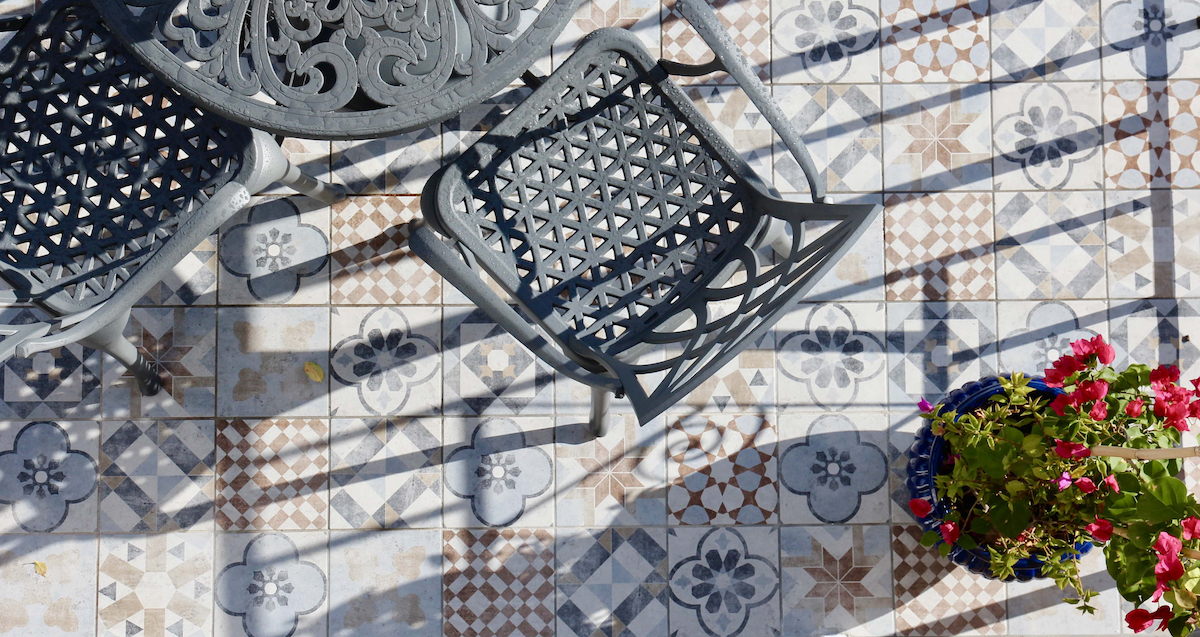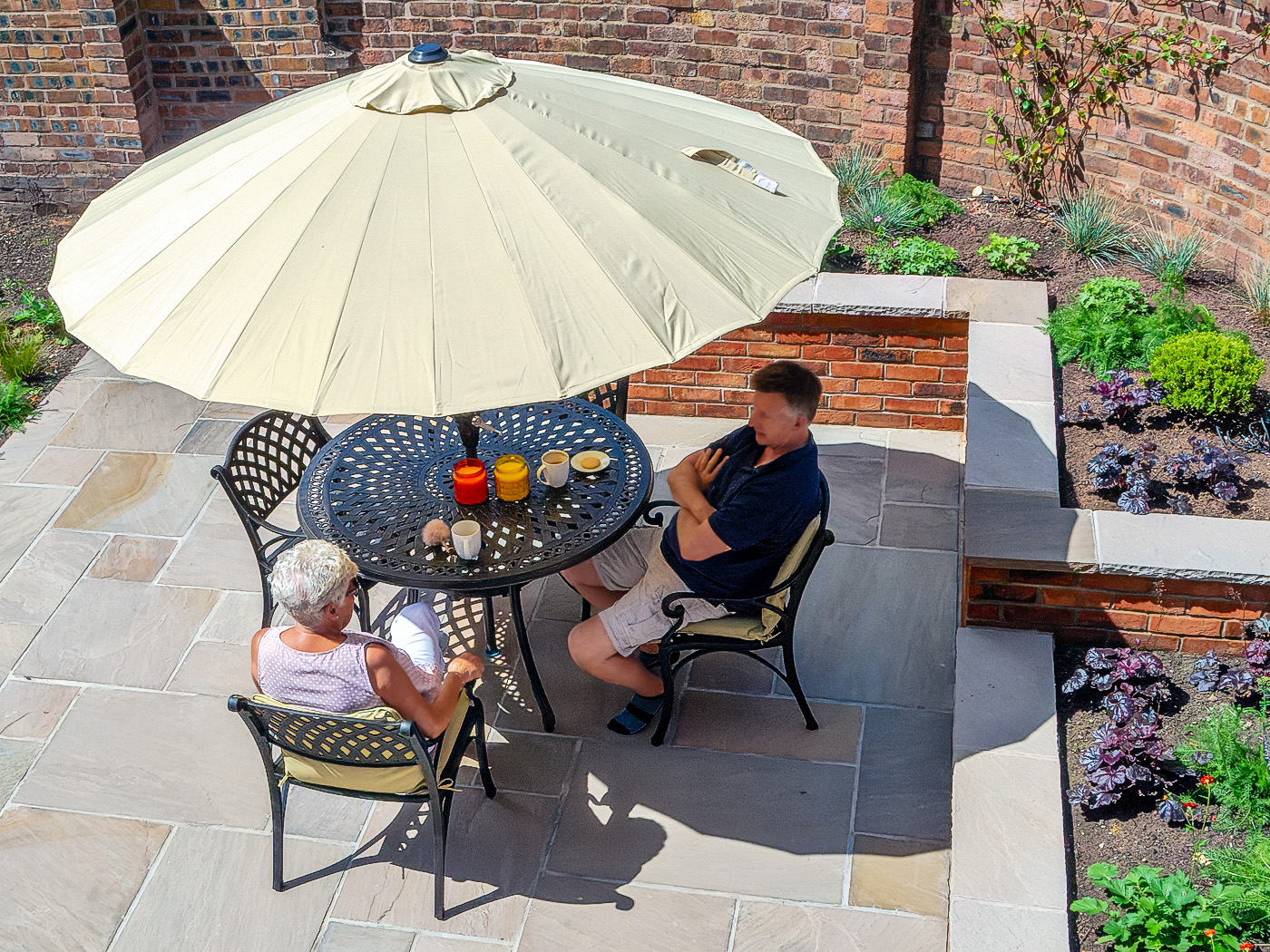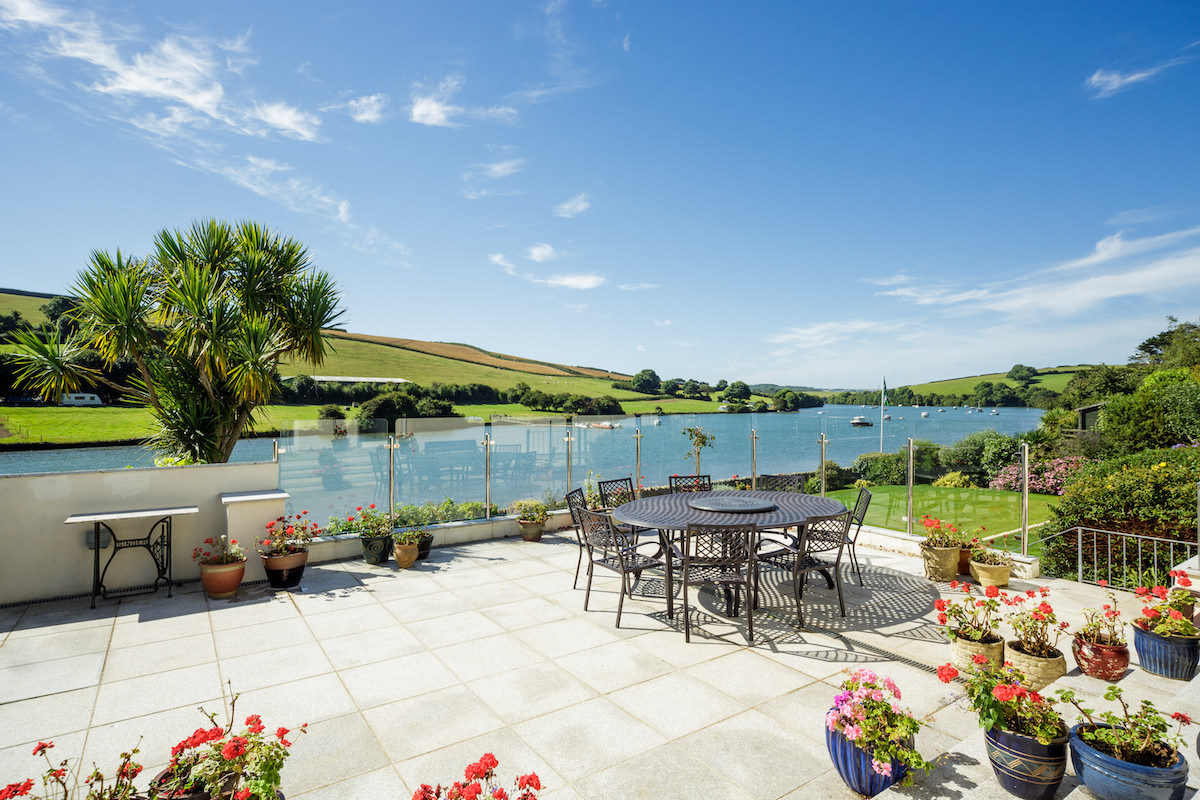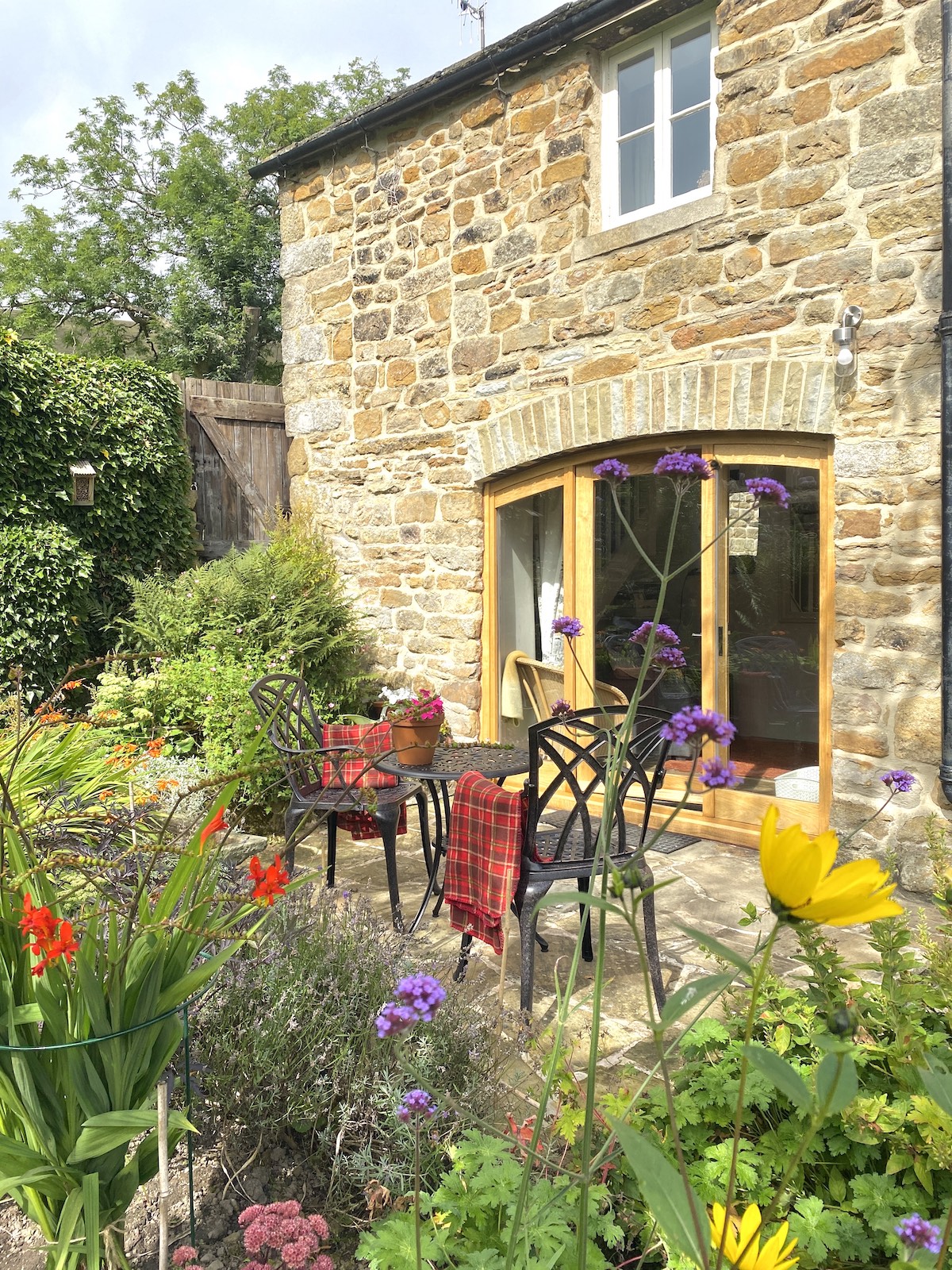Can the principles of garden and interior design be applied to the layout of your patio? Surely what makes a well-designed patio, garden or room inside the home is the same and thus the same rules apply?
At Lazy Susan we will often say in our garden design-focussed articles that the Patio Furniture is one of the most important elements, so the idea of designing your patio around it sort of makes sense in theory.
However, it is not always as simple as that in practice…
A well-designed patio needs all the main ingredients to come together and work in harmony:
- Hardscaping
Patios, paths and garden structures such as sheds and pergolas, etc - Landscaping
Lawns, planting, trees, shrubs, borders, containers, etc - Outdoor Living
BBQ, patio furniture, etc - Garden Accessories
Outdoor lighting, heating, etc
In many ways, the best-designed patio spaces are viewed as a room within a bigger space that incorporates (and works in harmony with) the rest of your outdoor space and the home itself.
If we are comparing patio design to interior design, it is closer in form and design principles to that of open-plan living.
The space is often best when ‘zoned’ but it must still flow (how the eye moves through it) and function (how you move through it) as one.
That space could incorporate kitchen, dining and living room all in one, which is now a common feature in many modern homes (be it city flat or large suburban detached property).
We’ve moved away from formal to a more casual multifunctional family-friendly space with entertaining at the heart. The same is being reflected in our gardens, but especially on our patios.
However, the issue for many is that designing this type of space is often a tricky thing. If a space (inside or outside) has to serve multiple functions, then it is much easier to get it wrong.
A well-designed patio much like a well-designed kitchen in an open-plan living space must work in harmony with what’s going on around it.
What makes a good patio layout?
In this post, we’re primarily focussing on the patio area, although we will make (and already have made) reference to the wider outdoor space of the garden and access to and from the home if applicable.
The patio is generally the central or focal part of the garden, the place of concern to us here at Lazy Susan, and a good patio is one that meets the needs of the user(s) and enhances how they enjoy their home and garden.
Patio Furniture is critical to that enjoyment. Much of the quality time spent in your garden (unless a keen gardener) is sat on patio furniture when the sun is shining
We’re not saying you should (although we believe you most certainly could) design the full garden around our patio tables (it is a key “component”), but the functionality and positioning will have a significant impact on the design and layout of the space.
When it comes to defining good design though, be it room, garden or patio, that’s where things become a little tricky, it is subjective, influenced by a wide range of factors, and well, open to breaking a few rules too.
Apply our patio design principles to your garden
Whilst defining good patio design is a little tricky, the basic principles we’ve selected in this post can be applied in various ways to improve the design and layout of your own patio.
They’re essentially the building blocks or laws of good design, which if applied correctly will help create the sense of balance, contrast, diversity, harmony, proportion, repetition and rhythm that makes a patio look good.
Good garden and patio design are as much creative as they are scientific, and creativity is of course very personal.
However, it is about taking these principles and applying them in ways that inspire you, fit with the space you have, work with the style of your home and how you like to use the space, etc.
However, for us, the key to making a patio truly work and a place you enjoy using is always the Patio Furniture.
You can use it as a focal point that invites people outside and creates a point for which to relax and take in the wider outdoor space.
Here we are taking what we consider the main fundamentals of good design and looking at how they can be best applied to your patio to get a space that works for you.
We will also utilise photographs that our customers have sent us for our Do Some Good campaign to Hopefully illustrate and explain why we think certain layouts work best with our furniture.
1. Start with a focal point
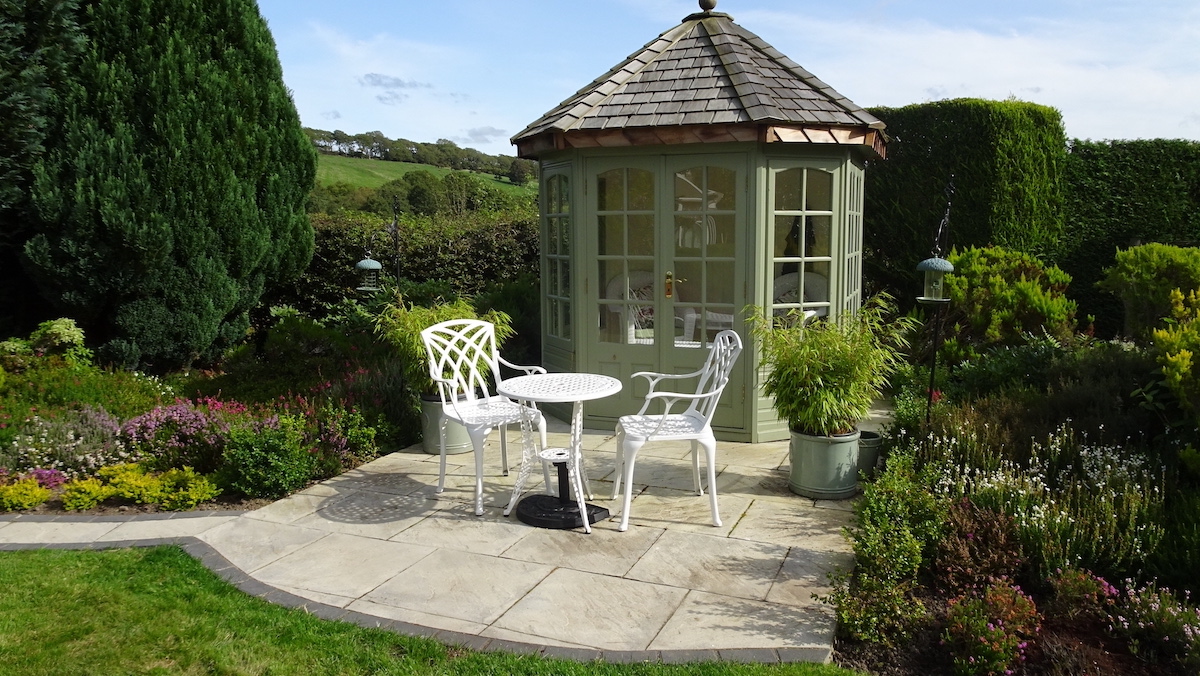
A focal point is always a great starting point and it is a foundational component of good interior, garden and patio design.
It is basically the star of the show and a good one is a central element in the garden, designed to draw the eye and anchor the whole space together.
A garden can have a number of focal points that take you on a journey but the golden rule is that less is more, 2 to 3 max in an average size garden.
This is illustrated in the photo above where the garden building and large trees, grab your attention. The garden furniture is then perfectly scaled to support the scene.
The aim is to lead the eye to an item of particular interest. Too many focal points and the space can become confusing.
On a patio, the Patio Furniture is often the largest item, the thing to which we are drawn, so it naturally becomes a focal point.
However, that doesn’t mean you can just plop it on there and voila. The large trees in the photo below almost become part of the surrounding view, so our furniture is what draws you into the space.
It has to be positioned correctly with regard to balance and harmony, blending with the scale of the garden and the customer below has got this spot on.
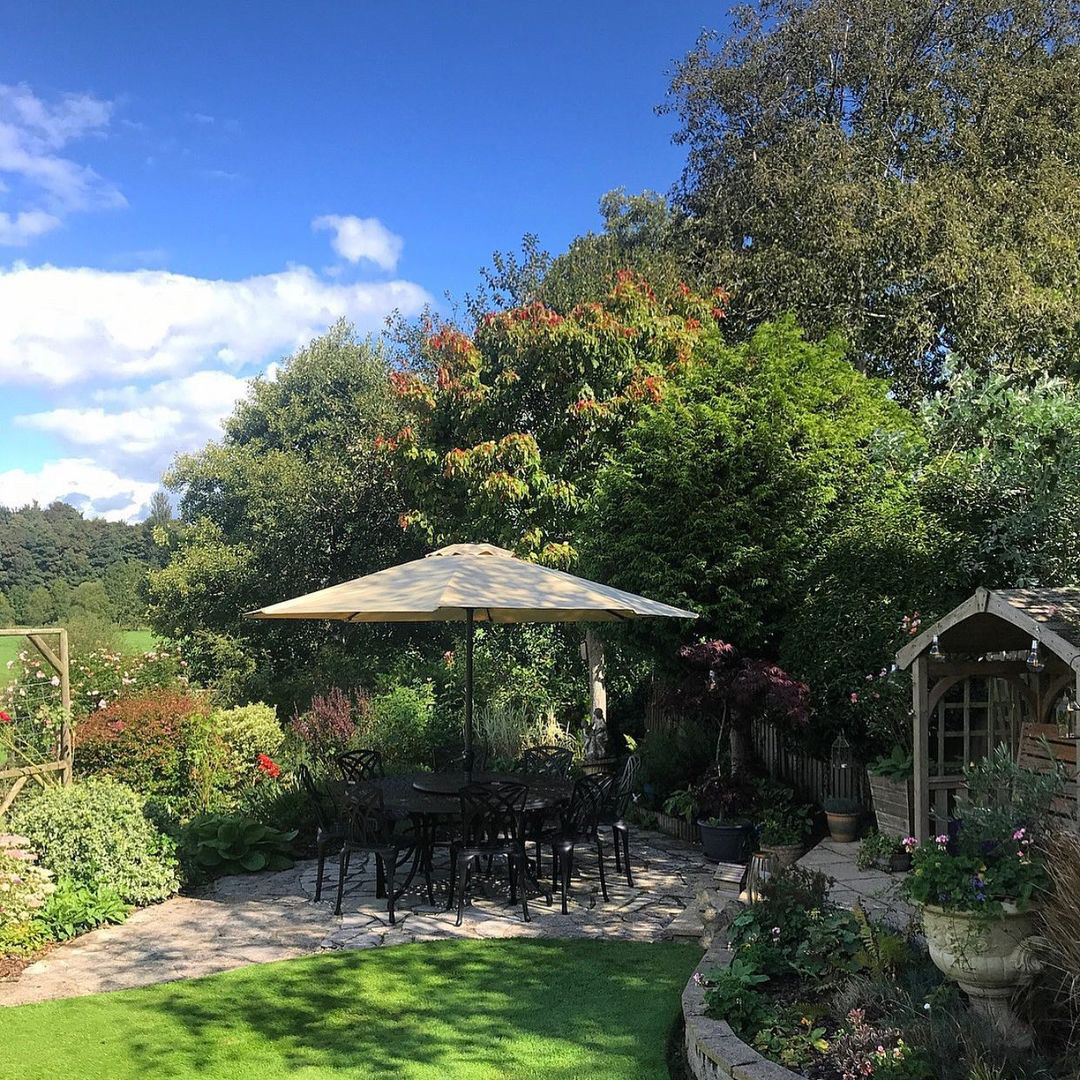
If you're struggling to decide where to put your patio furniture, then look for the point that catches the eye from the inside of the home.
Our eyes naturally follow lines, so a strong focal point is often where visual lines in your garden intersect, be it a sight line from the access point (such as a patio door) or in line with a pathway to or from the patio.
Working with the line of sight can help you find the perfect position for your patio furniture.
By using your furniture as a focal point, you’re also creating a place for the eye to settle on your patio whilst also allowing for movement around the space and flow into the rest of the garden.
2. Think about scale and proportion
Scale and proportion are also critical principles when creating a patio space that not only looks good but functions.
From basic questions like does the size of the patio table set fit with your patio and the other items around it, to the more complex of working with the size of your home to determine the scale of hardscaping and landscaping.
When looking at an object such as a patio table, our brain looks to (often subconsciously) analyse it. We want it and need it to ‘fit' with its surroundings.
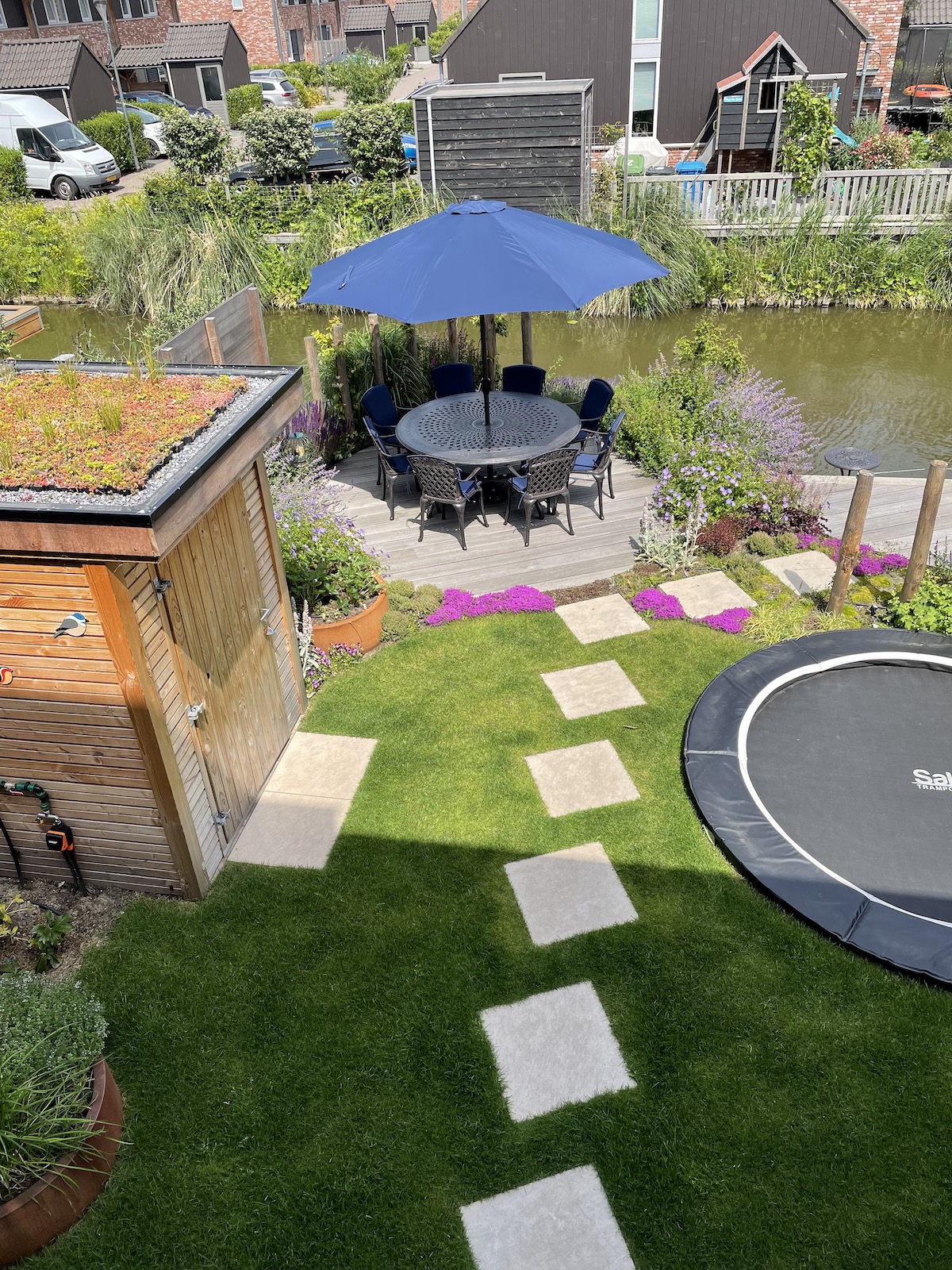
When choosing new Patio Furniture for your patio it is important that it fits in terms of scale, whilst patios should be constructed to a scale that works with your home and the wider garden/surroundings (illustrated perfectly in the customer photo above).
Too big or too small and you create disproportion. Things look odd and like they’re in the wrong place.
Elements such as walls, patios, paths, etc are often fixed from day one unless you rip them out and start again. If that’s not on the cards, then the items you put on and around must work in terms of scale and proportion.
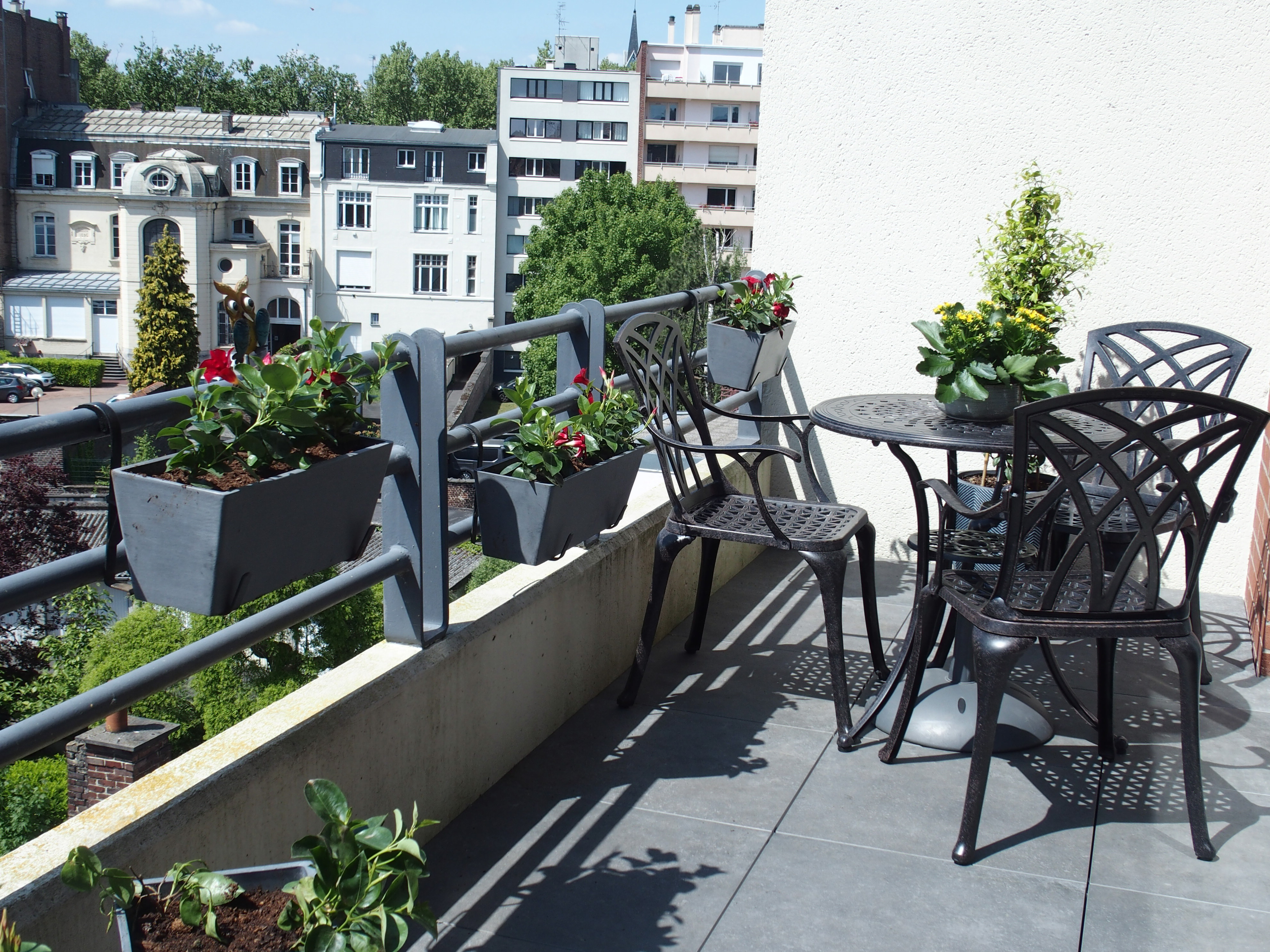
However, you can also play with scale. It is not always about having things in perfect proportion…
For example, in a small space such as a balcony or city garden, one or two larger items can trick the eye into thinking the space is bigger (as shown in the photo above), whilst filling it with lots of small things does the opposite and make it feel small and cluttered.
3. Think about balance
Good scale can also be created by good balance. And balance is best maintained between all the different design components, in terms of not just size, but colour and shape too.
For example, if you place a large circular table set on one side of a patio, what you place on the other side is important to give you natural balance.
In the larger garden design scheme, if you have a circular patio positioned centrally, what is around it in terms of pathways, trees and shrubs to create that visual balance?
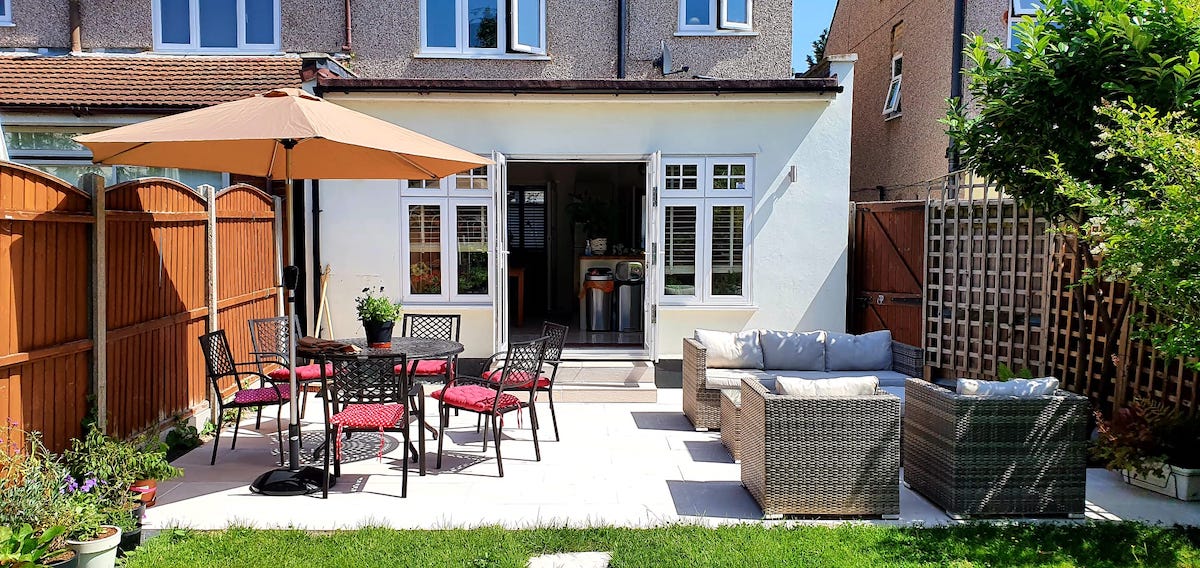
Balance is often best achieved when the elements on each side of a real or imaginary axis are equal. Everything that is placed in a design will carry a certain visual weight with it.
A patio table to one side of a patio can be complemented by a large item on the opposite side, such as the sofa set in the customer photo above.
Yes, you will use the patio furniture the most, but the experience is only enhanced by what’s around it, and often, it is the details that truly make a space work and the finished design feel balanced.
4. Trick the eyes
This follows from the balance in that you can use various elements to also trick the eye into creating what it perceives as a good garden design and patio layout.
For example, you can use garden art, mirrors (as shown in the photo below), lighting, planting and paving in interesting ways to create an optical illusion to add depth or intrigue and makes things visually interesting.
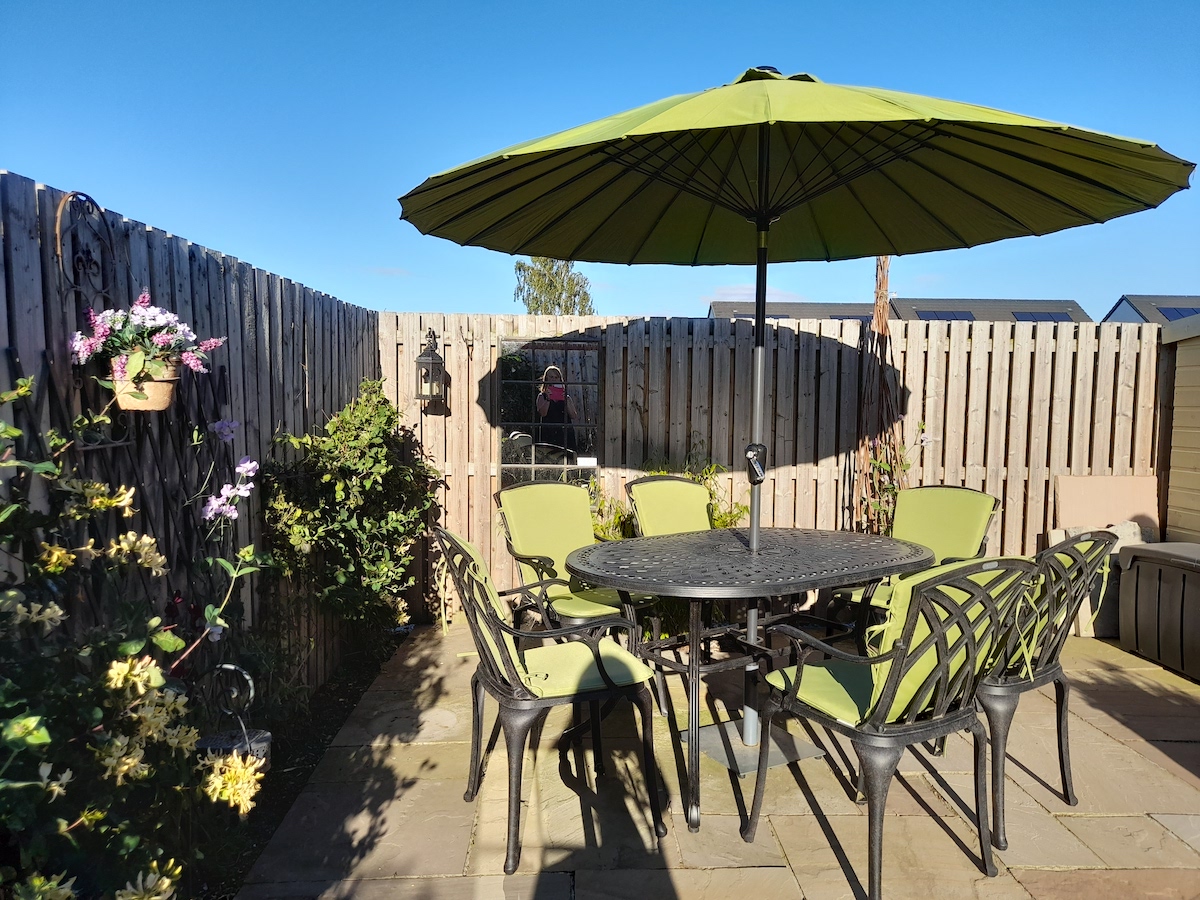
By playing with the perspective you can make a small patio or garden feel bigger and a larger patio more intimate and inviting.
A great example of this is by using linear paving or decking on your patio rather than square or rectangular pavers. The lines help draw the eye to the end of the space and beyond.
The clever positioning of outdoor mirrors in the customer photo above gives the impression of extending to another part of the garden, while the reflection of the garden itself creates a greater sense of space.
5. Play with height
There are a number of ways you can play with height to create a good garden and patio design, from raised seating areas to incorporating garden structures such as a pergola, for example
Introducing height onto your patio will bring not only visual interest but solve a host of issues such as shade in summer, shelter from the wind or privacy from your neighbours.
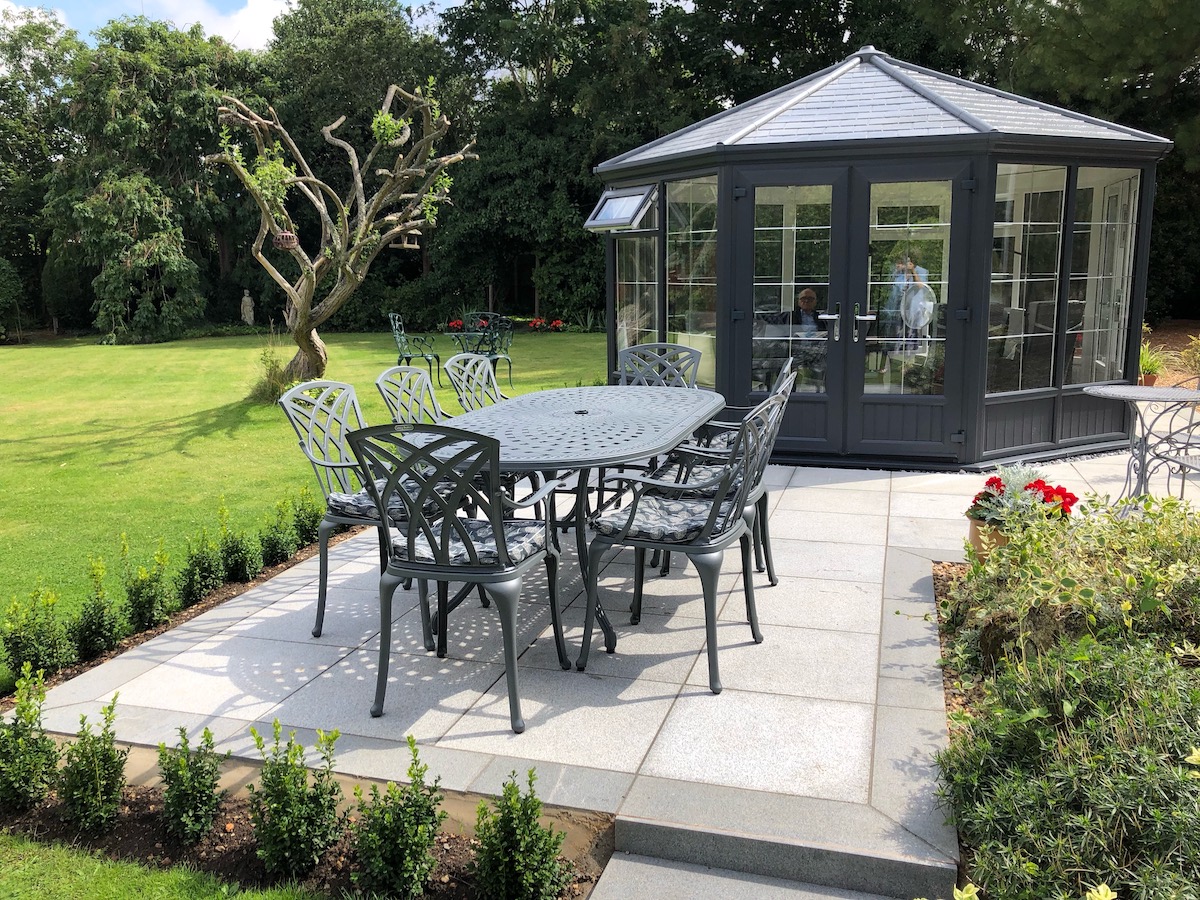
In overlooked gardens adding height will help not only block out those around you but will help to create intimacy and a sense of enclosure.
Both large and small spaces can benefit dramatically by adding height. It can again help to make smaller spaces feel bigger by drawing the eye up instead of down.
In larger plots, adding height provides the opportunity to break the space up (as the customer has done by pairing a gazebo-style summer room with a patio dining area), and create a strong focal point that draws the eye or acts as a gateway to a different part of the garden.
6. Think about the flow
Think about flow around and on/off the patio. Think about how you use your outdoor space, set up the patio to fit, as a place to spend time and create conversation.
Good patio design has to not only look good but be practical and inviting to use.
At the end of the day, a successful patio is one that makes us spend as much time as we can outside. Be it eating, socialising, reading or just relaxing.
Creating good flow is such an integral part of that.
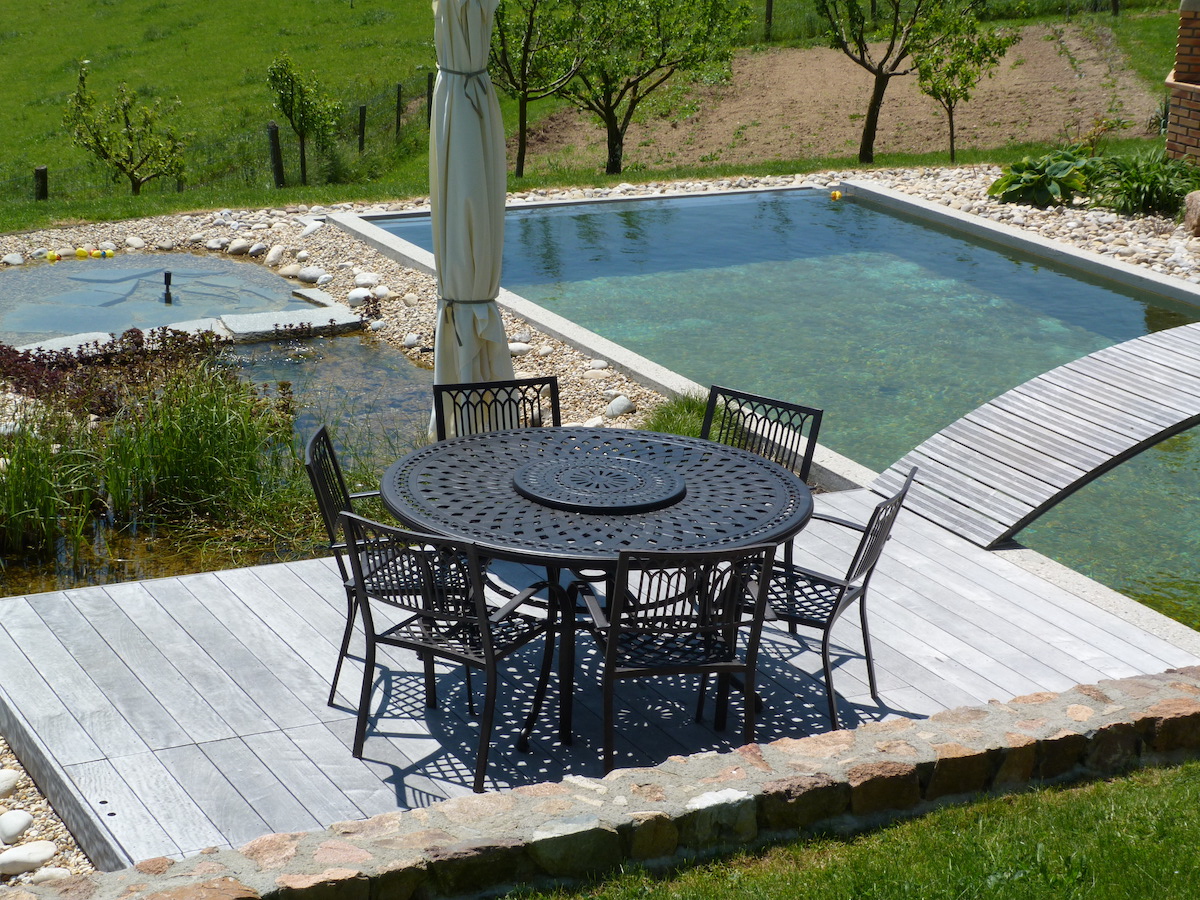
How you enter the garden, what you first see on your patio, and how you move around the space, are the elements that create a good flow of movement around the space.
Perhaps from the patio doors, you want to step straight into an outdoor dining area, but where from there?
As you walk to the rear of the garden do you want the space broken up with planting or a direct clear view of a focal feature?
However, a good flow is about more than just the physical too. It is the full experience. It is about stimulating all the senses and the feeling you get as you enter your outdoor space.
A well-designed patio takes it all to create flow and movement that results in a space that pulls you outside. Without it, it will just feel flat, unloved and uninspiring.
Take a critical look at the garden and see how you can improve it. How can you make it look and function better?
Subtle tweaks to the positioning of items on your patio can make a big impact.
Good garden and patio design is achieved when all the building blocks fit together as one whole - landscaping and hardscaping working together in harmony.
A patio should always feel like an extension of your home. An extra room without the need (and cost) to actually extend your property.
Considering what you will need from this space and how it will serve your lifestyle, as opposed to simply copying an idea you have seen in a magazine or a friend's garden, is key to making that “open plan” space work for you.
The best designs meet your own personal brief, and no matter if you're starting a new patio design from scratch or looking to adapt an existing one, explore the different fundamentals to see how you can make the space feel larger, brighter or more private.
We can’t give you the all answers, for that we’d have to charge a consultancy fee, but hopefully, this article has you asking the right questions?!
If you’ve got any photos of your Lazy Susan Garden Furniture in situ, then we’d love to see them for our Do Some Good charity campaign!
You can tag us @LazySusanFurniture on Instagram or Facebook or email them to us at [email protected].




